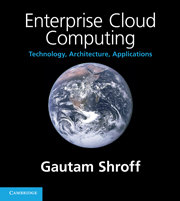Book contents
- Frontmatter
- Contents
- Preface
- List of abbreviations
- Part I Computing platforms
- Part II Cloud platforms
- Part III Cloud technologies
- Part IV Cloud development
- Part V Software architecture
- Part VI Enterprise cloud computing
- Chapter 17 Enterprise cloud computing ecosystem
- Chapter 18 Roadmap for enterprise cloud computing
- References
- Index
Chapter 18 - Roadmap for enterprise cloud computing
Published online by Cambridge University Press: 06 December 2010
- Frontmatter
- Contents
- Preface
- List of abbreviations
- Part I Computing platforms
- Part II Cloud platforms
- Part III Cloud technologies
- Part IV Cloud development
- Part V Software architecture
- Part VI Enterprise cloud computing
- Chapter 17 Enterprise cloud computing ecosystem
- Chapter 18 Roadmap for enterprise cloud computing
- References
- Index
Summary
We are nearing the conclusion of our exploration of cloud computing; along the way we have also covered many aspects of enterprise architecture. Certain aspects of enterprise architecture may need to adapt to or be replaced by emerging paradigms, such as PaaS or Dev 2.0. At the same time many enterprise applications can, technically, be easily deployed in an IaaS cloud. We have also examined the question of cloud economics and shown that in principle public cloud can be cheaper, due to elasticity, and also faster to use, due to automated provisioning. We have also noted the additional cost advantages of PaaS platforms that enable public facing applications to be made available at no cost, with charges accruing only once load increases.
So, where could, and should, an enterprise begin leveraging the cloud? There are valid concerns with using public clouds from an enterprise perspective, especially with respect to (a) data confidentiality, lock-in, and auditability as well as (b) software licensing. Enterprises are still wary of placing production or sensitive data in the cloud, since current cloud offerings are essentially public networks and hence exposed to more attacks. While there are no fundamental obstacles to making a cloud environment as secure as an in-house data center, this requires careful planning using encrypted storage, virtual LANs and network middleware. Some cloud providers have begun to take the first steps towards these levels of security, such as Amazon's VPC.
- Type
- Chapter
- Information
- Enterprise Cloud ComputingTechnology, Architecture, Applications, pp. 253 - 263Publisher: Cambridge University PressPrint publication year: 2010



